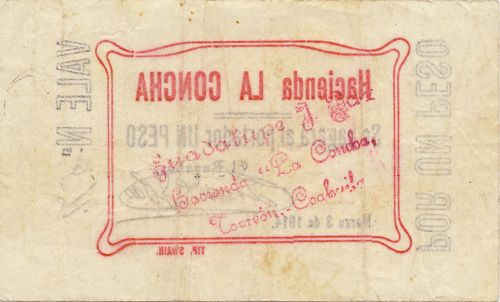Private issues
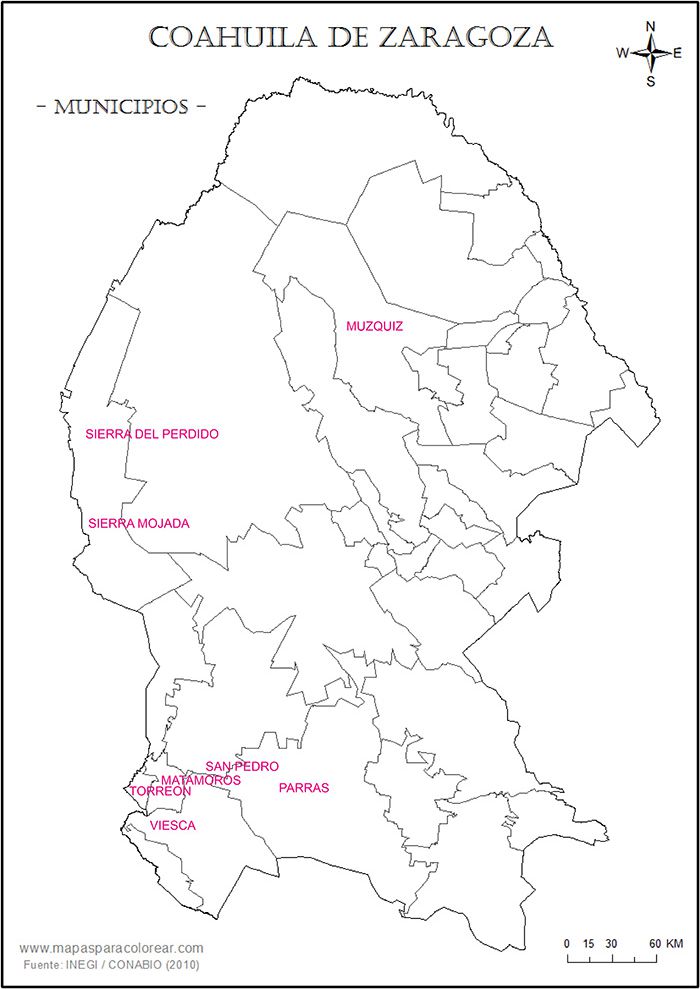
The private issue from Coahuila mainly come from the prosperous región of the Comarca Lagunera around Torreón and either from the period when communications with the rest of the country were disrupted (late 1913 to early 1914) or late 1915. Many are from haciendas and would have been used to pay the workers when currency was unobtainable.
On 28 September 1915 Alvaro Obregón wrote to Carranza in Veracruz from San Pedro de las Colonias, asking him to send one, two and five pesos notes to relieve the lack of change. A group of hacendados had complained about the difficulties caused by the lack of funds and suppression of the Villista currency. Obregón had lent them $250,000 to make their payrolls but felt four million pesos would be needed for the whole of the Comarca. The next day Carranza replied that he had already sent $1,500,000 and would send more. In the meantime Obregón could authorize solvent local hacendados to issue bonos for the amount that he mentionedABarragán, caja III, exp. 28.
Given the close connection between Torreón and Lerdo and the city of Gómez Palacio, across the state border in Durango, these notes should be studied alongside the private issues of that other state.
Múzquiz
José E. González
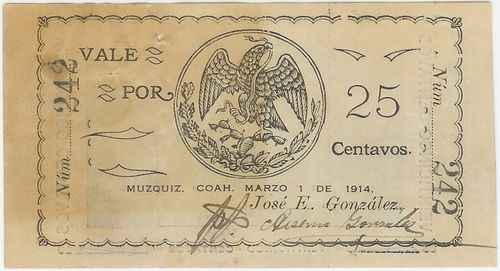
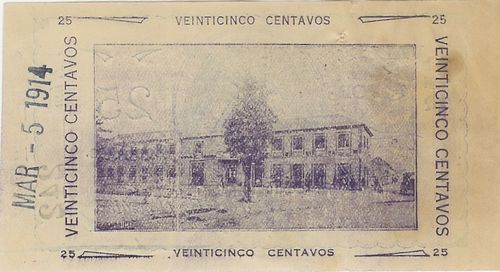
| date on note | from | to | total number |
total value |
||
| 25c | 5 March 1914 | includes number 242 |
Also listed here as a private issue but this could well be a municipal issue, with José E. González the [ ] and the building one on the main square, which was functioning as a school in 1905 and since 1984 has housed the Museo Histórico de Múzquiz. The note is signed by Arsenio González, as per pro José E. González.
|
Arsenio González On 17 February 1912 the governor Venustiano granted an Arsenio González of Muzquiz an exemption from taxes for the $10,000 that he was going to invest in an ice plantACoah, FD, caja 59, folleto 4, exp. 11. Later in 1920 he was granted a contract to build a flour millXXIV Legislatura (1920-1921) Gobernación, exp 44, decreto 467. |
 |
Sierra del Perdido
Rancho "El Salvador"
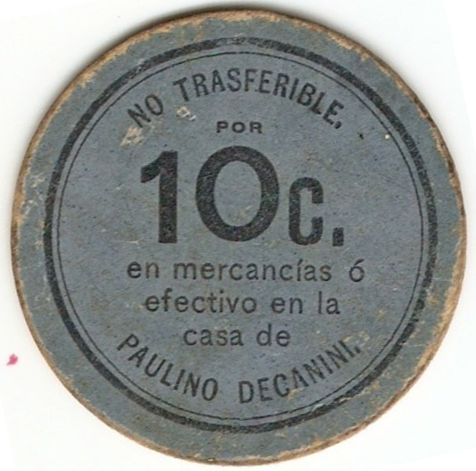
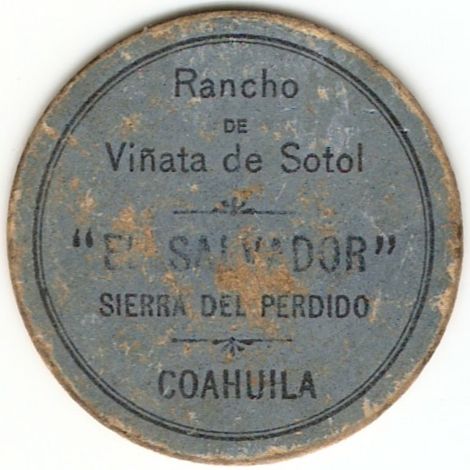
A nontransferable token for 10c, issued by the “El Salvador” sotolSotol is the Spanish name for the Desert Spoon, a plant that grows in northern Mexico, New Mexico and west Texas and is used to produce a distilled spirit, also called sotol, in a similar manner to the more common mezcals. Sotol was a popular drink amongst ranchers and miners. The first viñata (vineyard) de sotol was established in Parras de la Fuente in 1908. ranch that could be exchanged for goods or cash in the casa Paulino Decannini.
The senior Paulino Decannini was born in Lucca, Italy in 1868. He worked in Coahuila as accountant for the Compañía Minera Peñoles, and married Angelina Flores Serna, with whom he had seven childrenPaulino, Cesar, Oscar, Dante, Horacio, Angelina and Urania including another Paulino. He died in 1940.
Sierra Mojada
Mina “La Encantada”
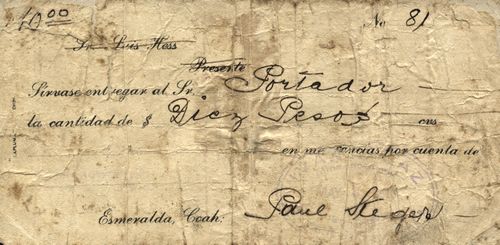
This is a personal cheque of Luis Hess, altered and made out to the bearer, for $10, dated 3 May 1913.
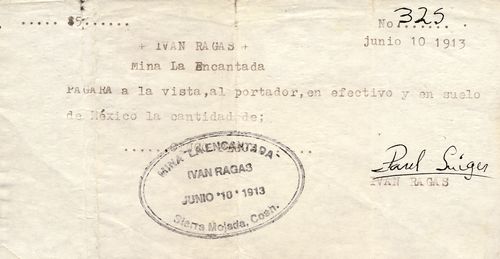
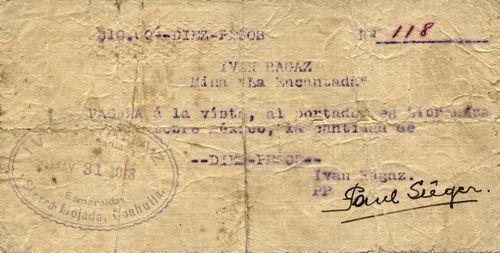
| date on note | to | from | total number |
total value |
||
| $5 | 10 June 1913 | includes numbers 206CNBanxico #10213 to 325 | ||||
| $10 | 31 May 1913 | includes number 118 |
These typewritten notes, to the bearer and at sight, were issued by Ivan Ragas (or Ragaz) in mid 1913. Ragaz was a mining engineer from Andeer, Switzerland. In 1903 he had been superintendent of the Sierra Mojada mines in Coahuila and the Santa Eulalia mines near Chihuahua for the Guggenheims, but then took over the management of the operating department of the Stilwell mining interests, headquartered in Chihuahua CityEl Paso Daily Herald, 28 April 1903.
All are signed by Paul Sieger.
| Paul Sieger |  |
Torreón
On 12 November 1913 the Mexican Herald reported that the stores in Torreón were open and doing business as well as could be expected under the trying circumstances that prevailed there, and that on the cotton plantations in the Laguna district picking was going on though, as the planters would not be able to market their cotton, they would be obliged to store it until the railroads re-opened. The greatest difficulty that the merchants and planters had to contend with was the scarcity of money. The rebels had not issued any fiat money, as they had done in Durango, but a number of the large planters were paying their employees in vales, which were accepted by the merchants of Torreón and surrounding towns. When a merchant had accumulated a number of these vales, amounting to about $100, he turned them over to the planter who had issued them and received a draft for the amount. The plan, so far, was working well with the vales passing as currency and not being discountedThe Mexican Herald, 19th year, no. 6,647, 12 November 1913.
In late February 1914 the Jefe Politico of Durango, Silvestre Dorador, prohibited companies from issuing paper money or tarjetas de valor. He gave them 15 days to withdraw their issues or face punishment under the law¡Patria Libre!, Tomo II, Núm. 20, 17 February 1914. Ironically, Dorador was a printer and so might have produced some of these vales.
Hacienda La Concha
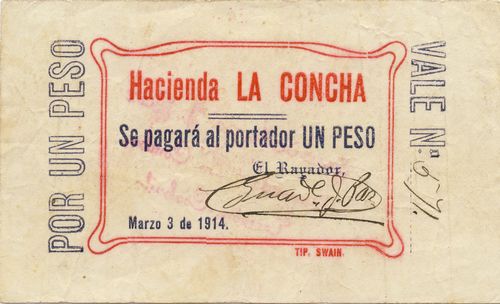
| from | to | total number |
total value |
||
| $1 | includes number 571 |
The hacienda “La Concha”María Vargas-Lobsinger, La hacienda La Concha. Una empresa algodonera de La Laguna, 1883-1917, Universidad Nacional Autónoma de México, Mexico, 1984 was the oldest ranch in Torreón, owned by Carlos González.
This $1 note, from March 1914, is signed by the accountant (Rayador), Guadalupe J. Paz.
| Guadalupe J. Paz | 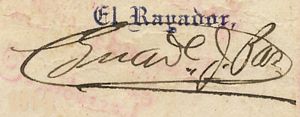 |
La Concha was one of the haciendas confiscated by the Villista authorities who needed the revenue generated by cotton to pay for their administration. González fled and in August 1914 it was entrusted to Lázaro de la GarzaCEHM, Fondo Venustiano Carranza, carp. 56, leg. 6370 but on 29 October he wrote to Villa asking him to nominate someone else as administrator as de la Garza had too much else on his handsLG papers, 1-I-18: Letter from L. de la Garza, Chihuahua, to Villa, Zacatecas. 29 October 1914.
In September 1914 Fausto Gutiérrez, administrador of the hacienda Nazareno, also held the lease for La Concha, among other propertiesLG papers, [ ]: Letter from Fausto Gutiérrez, La Concha, to L. de la Garza, New York, 27 September 1914.
Manuel de la Fuente y Cia.

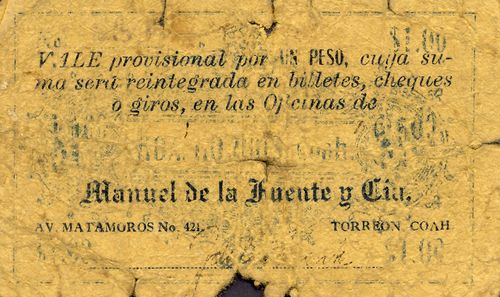
| from | to | total number |
total value |
||
| 50c | includes number 3782 | ||||
| $1 |
Manuel de la Fuente y Cia leased the Hacienda de Hornos, in the municipality of Viesca, just outside Torreón, from 1904. These 50c and $1 vales were to be redeemed in banknotes, cheques or giros in the firm’s offices at Avenida Matamoros 421, Torreón.
Casino de la Laguna

Founded on 22 April 1899, the Casino de la Laguna was a meeting place where the topics of politics and social issues directly affecting the residents of the city were discussed and debated. On 9 December 1907 a newly-formed company, Casino de la Laguna S.A., agreed to buy from the local council land on the main plaza for the construction of a new building, and this was opened on 15 September 1910, during the celebrations for the centenary of Mexican independence. The Casino was the site of the meetings in October 1913 when the victorious Villa demanded a forced loan from the principal businesses and the bank-on-bank cheques were planned.
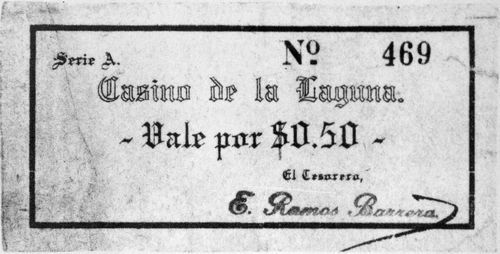
| series | from | to | total number |
total value |
||
| 50c | A | includes number 469 |
This note has the stamped signature of the treasurer, E. Ramos Barrera.
Agricultores de la Comarca Lagunera
By early 1914 some of the cotton plantations in the region had been abandoned and irrigation systems neglected so Eugenio Aguirre Benavides, who had been Presidente Municipal of Torreón in 1912, in his capacity as a General Brigadier and Jefe de Armas in Torreón, in May set up the Comisión de Agricultura de La Laguna, to resuscitate ranches, restore the irrigation and offer financial help. The Comisión was formed on 31 May 1914 with the leaseholders Miguel Torres, Manuel del Real Alfaro, Eduardo Gómez and Jesús R. Ríos, and operated under the auspices of the Villista administration in Chihuahua. On 30 March the Comisión confiscated the haciendas leased by Miguel Trad, namely Nazareno y anexas, Sombreretillo y anexas, El Refugio, La Trinidad, Codornices and Juan EugenioInforme of Jesús R. Ríos 24 October 1915 (CEHM, Fondo Venustiano Carranza, carp. 56, leg. 6370). The Archivo of the Comisión was taken to Chihuahua in September 1915 and so no doubt lost..
On 11 October 1915 the Carrancista military authorities instituted the Comisión Algodonera de la Laguna, formed of Pedro Ramírez, Carlos B. Prieto and Federico Compeán, with the aim of buying the cotton harvest for the government and also created the Comisión Interventora de la Laguna (Rafael Manzo, Mauro Uribe, Ricardo Zaldo, Alfonso R. Sotomayor and Jesús R. Ríos, who had been a member of the Villista Comisión de Agricultura) to confiscate the goods of those who had collaborated with Villa and to deal with properties that had already been intervenedManuel Plana, “La Cuestión Agraria en la Laguna durante la Revolución”, in Historia Mexicana, vol. 50, no. 1 (Jul - Sep 2000).
In October 1915 the Secretaría de Hacienda, with Carranza’s agreement, authorized[text needed] the main merchants and harvesters of Torreón to issue vales for fifteen million pesos, guaranteed with the product of their crops, whose value was estimated at thirty million pesos. This was done to obviate the difficult economic conditions in which the Comarca Lagunera found itselfEl Pueblo, Año II, Tomo II. Núm. 366, Veracruz, 9 October 1915.
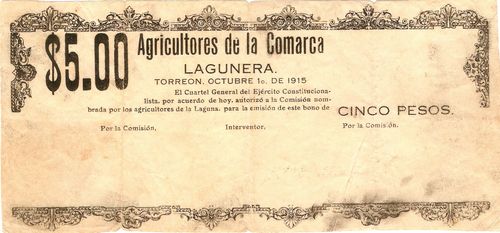
According to its text this $5 bono was issued in accordance with an authorization dated 1 October 1915[text needed] from the Cuartel General of the Ejército Constitucionalista. It was to be signed by two representatives of the Comisión and an Interventor.
The Continental Mexican Rubber Company
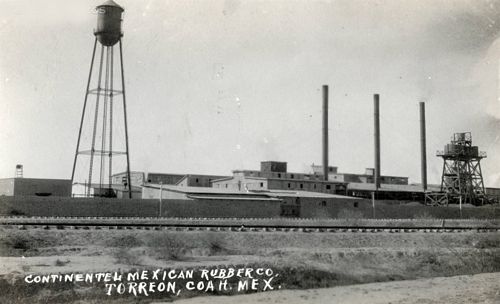
The Continental Mexican Rubber Company was formed in 1906 and constructed a large factory near Torreón, to process the guayule grown on its extensive properties in northern Mexico. However, by 1912 it had harvested and exported so much guayule rubber that its operation was both socially and environmentally unsustainable and this, together with social unrest (in 1910 Emilio Madero led a destructive mob against the company’s factory), caused the company to all but close down.
On 24 January 1916 the Continental Mexican Rubber Company asked Ramón Méndez, the Presidente Municipal, for permission to issue a series of cartoncillos[images needed]. This was agreed on the following conditions:
(1) there should be no more that $25 to $30 a week, redeemable within fifteen days and solely for use within the company;
(2) Any worker could redeem them in quantities of one peso or more. Redemption would be in legal tenderAMTor, Copiador de Presidencia Municipal 2, pagina 32.
Matamoros
Hacienda de Andalucia.
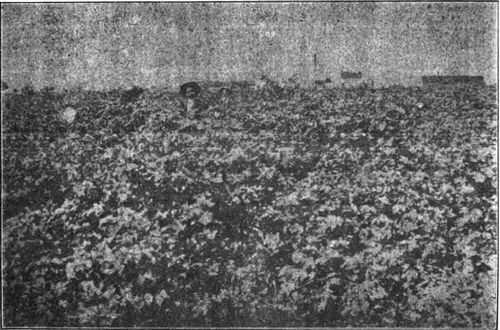
A cotton field in the Hacienda de Andalucia
This hacienda was situated in the municipio of Matamoros. It was owned by Rufino Torres or his heirsinformation from Oscar Treviño Cardenas, president of the Sociedad Numismática de la Comarca Lagunera. In 1905 this business, then owned by Sucesores de Tomás Rodríguez and leased by Eugenio Gorozave, comprised more than one hundred lots of land of the so-called "Cuadro de Matamoros" distributed between the Santo Tomás, El Potrillo, Irlanda, Flor de Mayo, Celaya and San Miguel ranches and the hacienda itself. "All the ranches, with the exception of Celaya and San Miguel, have their own irrigation channels, some derived from the channel of the main hacienda and others directly from the Rió Aguanaval. Their fertile lands produced cotton and all kinds of cereals, with a remarkable yield"Directorio Comercial é Industrial de la Laguna 1905-1906, Torreón, Gómez Palacio, Lerdo, San Pedro, Viesca, Matamoros.
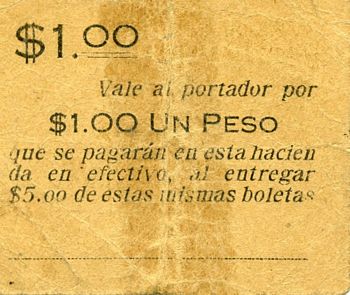
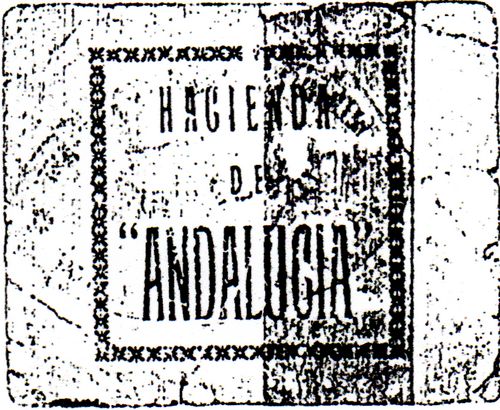
we know of a $1 note, redeemable in cash when presented in multiples of five pesos.

